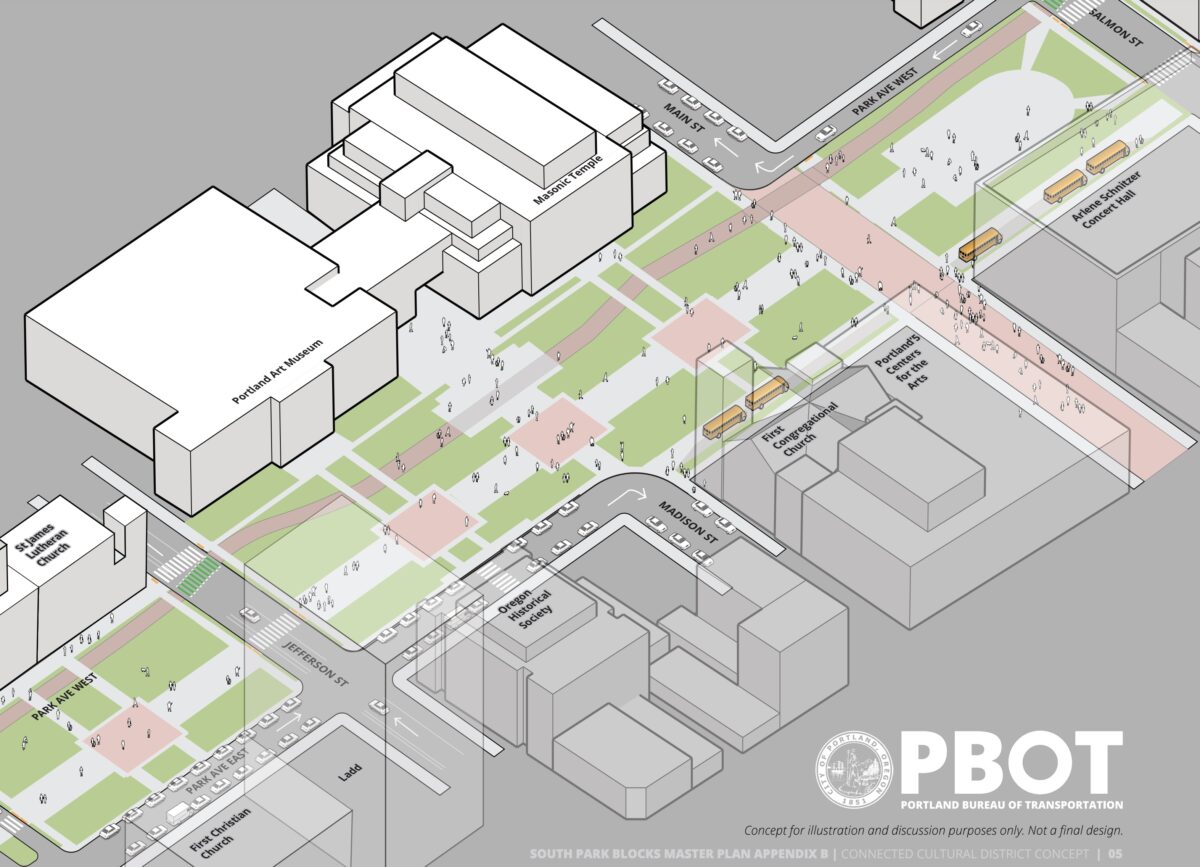
This is an opinion from BikePortland founder, editor, and publisher Jonathan Maus.
It’s unfortunate that the discussion about the future of the South Park Blocks has been poisoned by a misleading opposition campaign.
What we should be laser-focused on is something city planners call the Connected Cultural District Concept that would create the most exciting and significant carfree space in downtown Portland since a parking lot was turned into Pioneer Square in 1984. I mentioned this concept briefly in our story about the South Park Blocks Master Plan Update on Monday, but it deserves a much closer look.
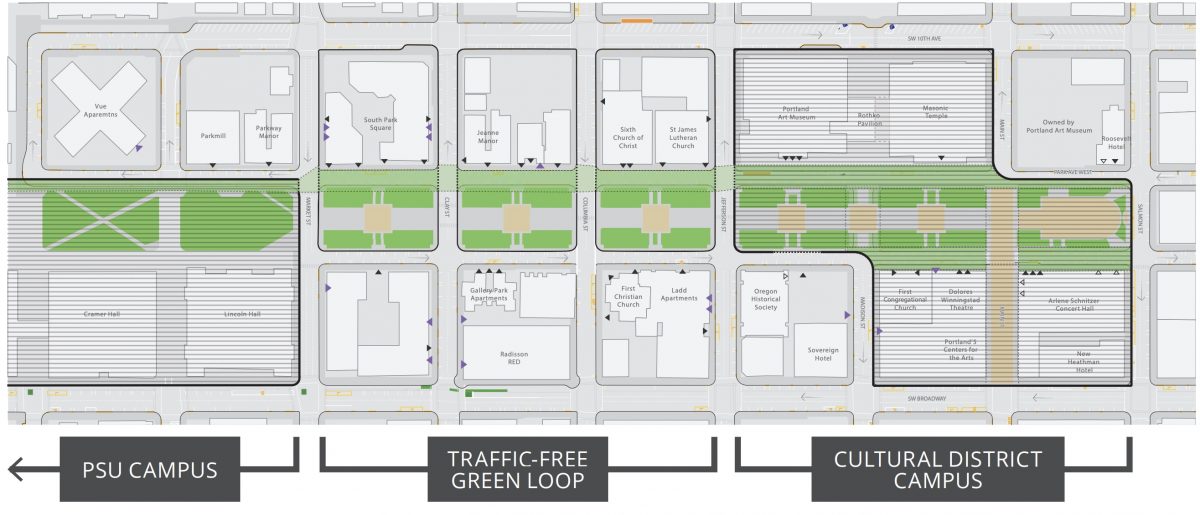
Led by the Portland Bureau of Transportation and Portland Parks and Recreation, the Connected Cultural District Concept emerged from their work on the master plan. In meetings during the public outreach process, city staff heard two key themes about the future of the South Park Blocks: “the desire to connect and expand the Park Blocks, and to minimize the impact of the streets surrounding them.” They responded by creating a 17-page appendix the master plan (Appendix B) that will be formally presented to City Council at 2:00 pm on July 7th.
A clear opportunity to push for an exciting carfree vision already sketched out (and all but endorsed) by two city bureaus, and with likely support from a majority of city council, is an extremely rare and valuable thing. This concept has real potential and we should take full advantage of our chance to get behind it.
In an email to BikePortland Wednesday, PBOT Senior Transportation Planner Nick Falbo referred to the concept as, “an emerging idea” and said even despite many unresolved questions about funding, operations, and access, “early conversations with stakeholders were supportive” . “It is included as an appendix to the master plan in part to offer the community something to rally around,” Falbo wrote. “Particularly for those who wanted to push the envelope a little more.”
Advertisement
“Those” could include a lot of Portlanders who understand that great cities are ones where people and places are prioritized over cars. There’s been strong support for carfree spaces in downtown for many years — from healthy city advocates and from many city council members — but we’ve always lacked a concrete vision to latch onto. This Connected Cultural District Concept is that vision.
What exactly does the concept entail?
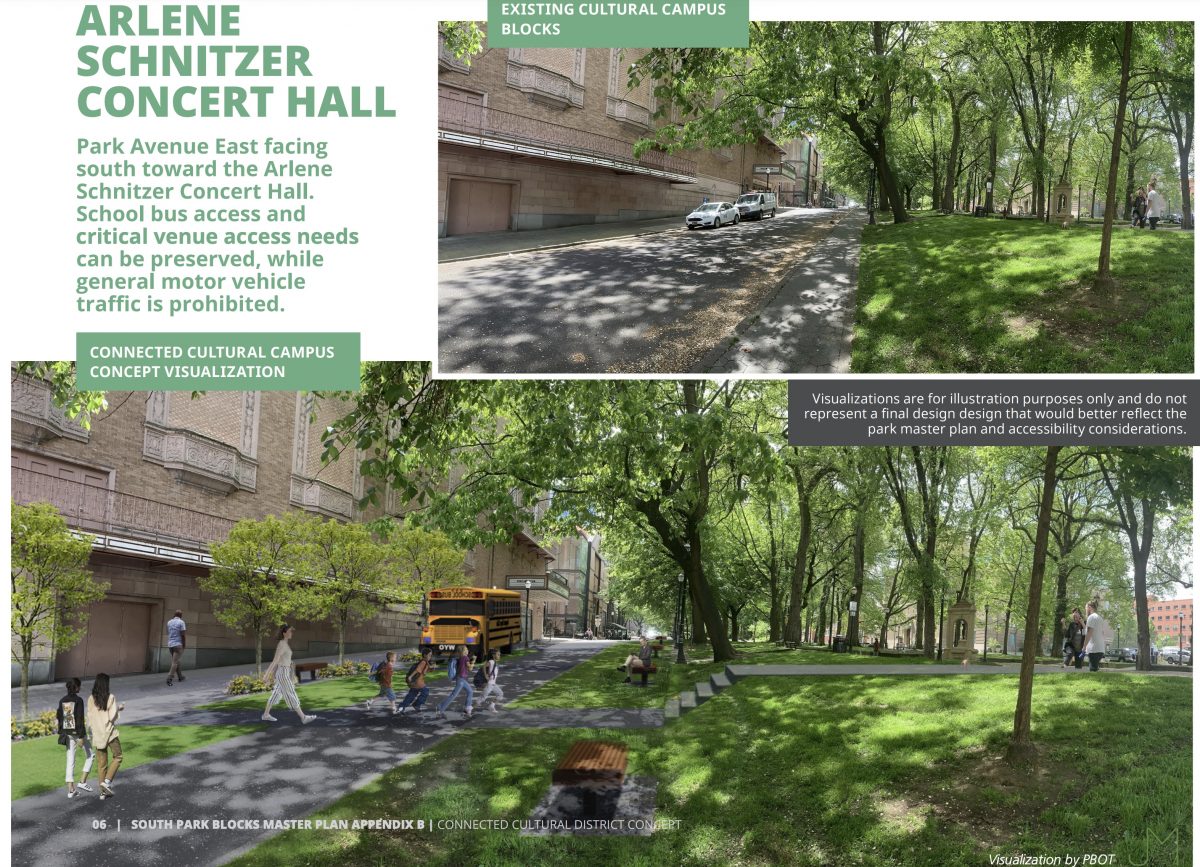
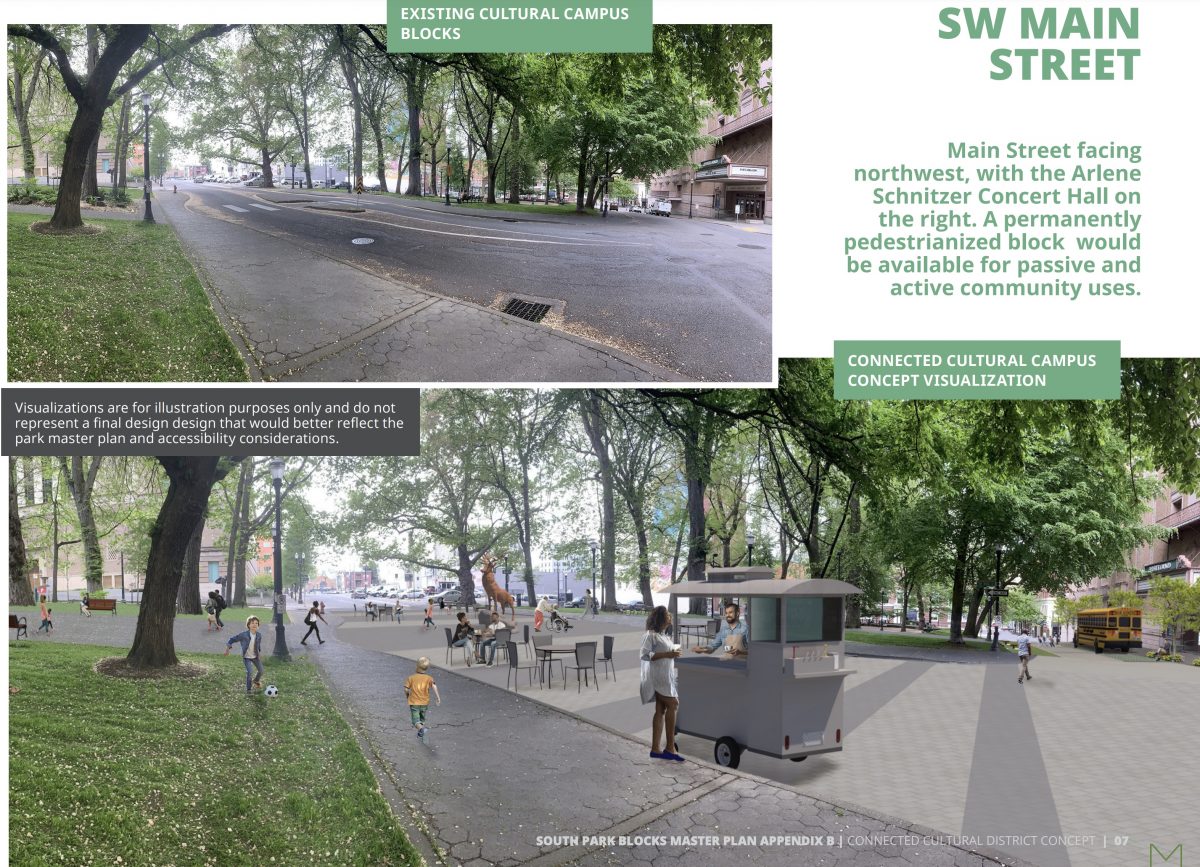

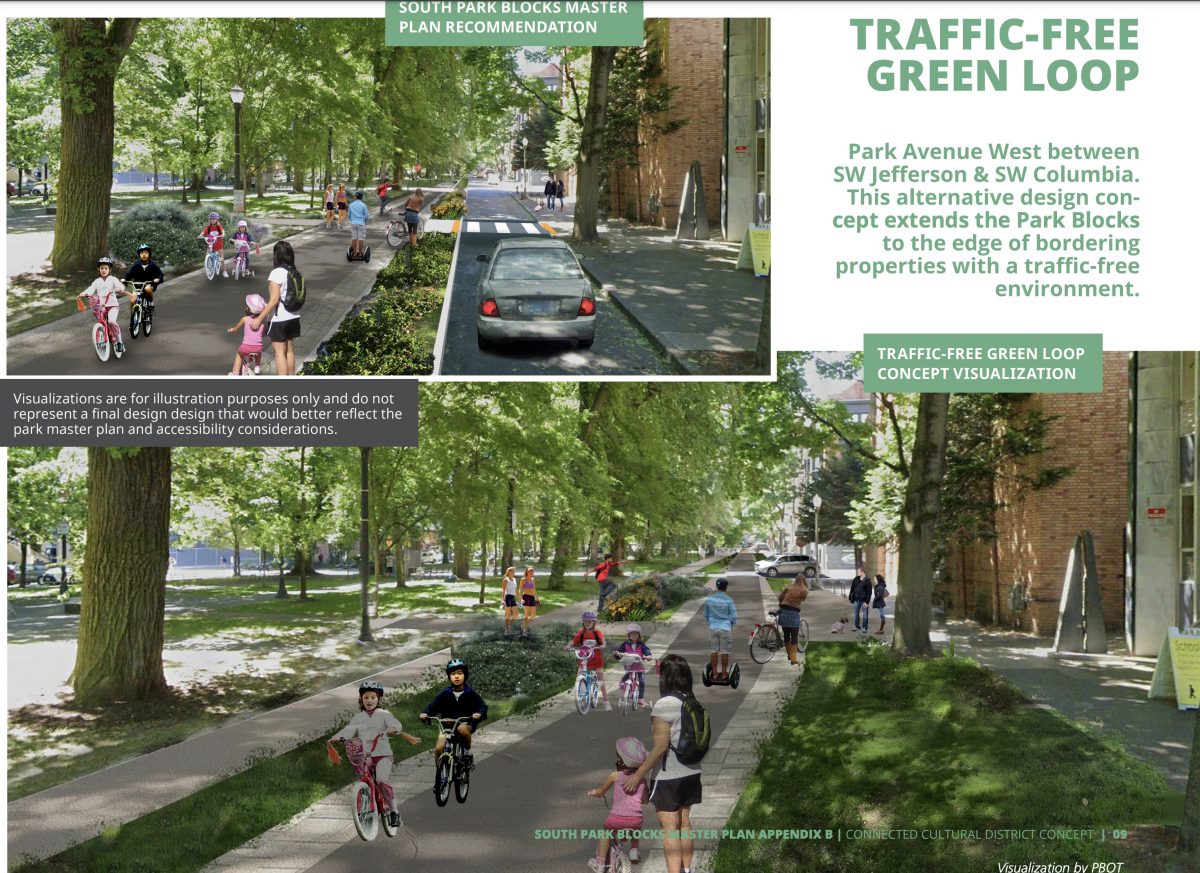
In a nutshell, it’s a recommendation to extend the park across SW Madison and SW Main streets and expand the plaza in front of the Portland Art Museum — a move that would create a larger park space, uninterrupted by loud, toxic, dangerous cars. PBOT and Parks refer to it as a “traffic-free Green Loop that would link the Cultural District campus and Portland State University’s pedestrianized campus to the south… ” (Note how the city uses “traffic-free” because it’s less controversial than “carfree”. The plan would create lots of traffic — it would just be mostly human-powered.)
Here’s more from Appendix B:
“Inspired by the transformation of the South Park Blocks through Portland State University in the 1970s, the Connected Cultural District envisions a campus for children, visitors, events and community activations to take place. The traffic-free zone would span from building to building, creating an expansive new experience, and opening new opportunities for community use. The Green Loop could extend this area as a traffic-free street on Park Avenue West.”
Specifically, the concept is to pedestrianize two blocks of SW Main Street, SW Park Avenue East, and SW Park Avenue West adjacent to the Portland Art Museum and the theater district between Salmon and Jefferson. It would also prohibit driving further south on SW Park Avenue West three more blocks from Jefferson to Market (where the Portland State University campus begins).
Advertisement
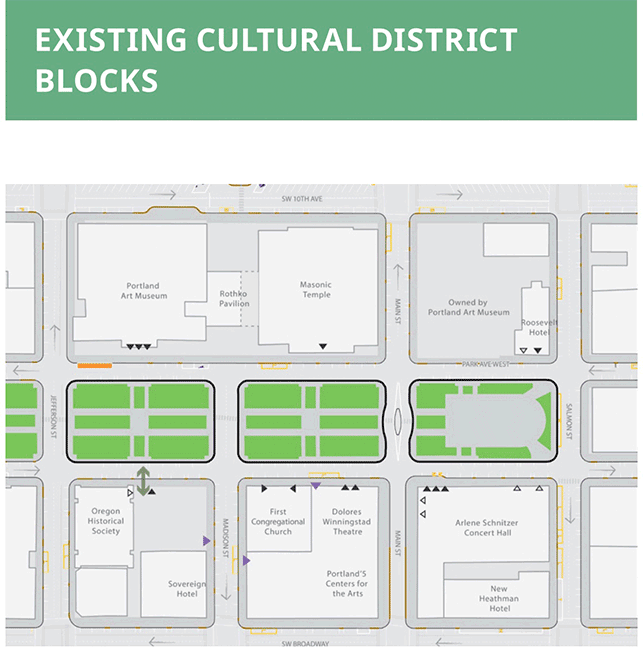
Given the rich cultural and community assets on these blocks, imagine the vast opportunities for new events and gathering spaces this could lead to. Portland Art Museum exhibits could spill into the park, performing arts groups could host plays, dances, concerts, and other events in a quiet, emissions-free, safe space in the heart of downtown.
I haven’t gotten an official comment from PBOT Commissioner Jo Ann Hardesty or Parks Commissioner Carmen Rubio about the concept yet, but it is very likely both are in full support of it. Hardesty has made her vision for more carfree spaces her highest transportation priority and it’s her bureau staff who’ve come up with the concept. Rubio’s office has told me she’s aware of the concept and is all-ears when it comes to hearing whether or not the community wants it to happen (I might have more on Rubio’s position Monday). There’s surely at least one more vote on the five-member city council (hi Commissioner Mapps!) to get this concept strongly endorsed and poised for its next steps at the hearing on July 7th.
To be clear, this is still just a concept. A very mature and well thought-out one, but a concept nonetheless. There’s no funding behind it and the hard conversations about access, maintenance, and operations haven’t even started. Even so, this feels like a major opportunity to rally behind a vision; a chance for Portland to stand up for something that will move our city forward and help us get our swagger back when we so desperately need it.
If you’re one of the folks who feels Portland needs to “push the envelope a little more,” when it comes to making downtown work better for people and not cars, please consider sending a quick note to city council members telling them how excited you are for the Connected Cultural District Concept.
mayorwheeler@portlandoregon.gov
mappsoffice@portlandoregon.gov
comm.rubio@portlandoregon.gov
joann@portlandoregon.gov
commissionerryanoffice@portlandoregon.gov
— Jonathan Maus: (503) 706-8804, @jonathan_maus on Twitter and jonathan@bikeportland.org
— Get our headlines delivered to your inbox.
— Support this independent community media outlet with a one-time contribution or monthly subscription.


